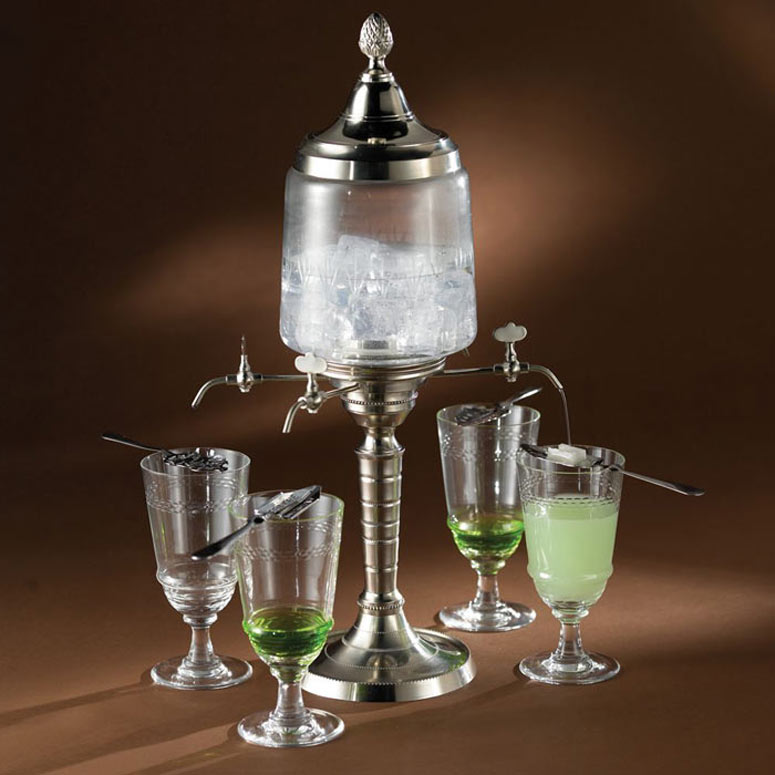
Whereas absinthe barware of the 19th century was primarily used as inexpensive promotional items, the modern versions are often cast of silver, or ornately manufactured to the standard of jewelry.Absinthe is the drink that needs little introduction, its reputation precedes it more than that of any other spirit in the world. Several companies produce replica absinthiana and several have modernized the traditional designs. As absinthe has re-emerged, so has the paraphernalia associated with it. A less common variation, called the bubble-reservoir glass, contains a bubble-shaped reservoir connected to the glass by a narrow neck or portal, which allows the absinthe and water to slowly suffuse into each other, accentuating the appearance of the louche.Ī revival of absinthe began in the 1990s following the adoption of modern European Union food and beverage laws which removed long-standing barriers to its production and sale. They were among the first type of glass made specifically for absinthe.

The term 'reservoir glass' describes several styles of stemware with a distinct bulge at the bottom volumetrically equal to a standard shot or sometimes a half-shot, the remainder of the glass to be filled with water providing the correct ratio of admixture. Some were simply etched with a line or marked by a glass bead, showing how much absinthe should be poured, with another line or bead indicating the level to add water up to. These would commonly have a short thick stem and faceting or some other feature to indicate the correct portion to pour. Sugar, if preferred, can be added directly to the bowl, or in some cases to a built-in grille.Ī Pontarlier reservoir glass with an absinthe spoon next to it.Ībsinthe was originally served in normal bar-ware, but eventually specialised glasses became somewhat popular. Ice and water are added to the bowl, which has a small hole at the bottom, allowing the ice-cold water to slowly drip through. A brouilleur is a glass or metal bowl which sits on the absinthe glass and acts like a personal absinthe fountain. In some instances a device called a brouilleur was employed. It allowed a small party of drinkers to accurately prepare their absinthe all at once with a slow, thin stream of cold water but did not require the steady hand required by a carafe. Most often it was a large glass globe on a tall metal stand that held between two and six spigots.

The carafe is held above the glass and water is delicately added in a thin stream.įountains appeared in bars and bistros in the late 1800s as absinthe gained greater popularity.

As with other items, many have been found with brand names on them.
#Absynth glass how to
Properly watering absinthe was considered by some to be an art form to be practiced with patience and finesse, and some bars were frequented by patrons humorously dubbed " Les professeurs d'absinthe" or absinthe teachers who, in exchange for a drink or a small fee would show new drinkers how to properly add water slowly, allowing the fullest flavor and aromatic character to be obtained from the drink.Ī water carafe is the most basic and original way to add water. The addition of water also causes a clouding, called the louche (called ouzo effect in other drinks). Today, many contemporary distilleries are also producing decorative branded barware for the same purpose.Ī rare six spigot Legler Pernod absinthe fountainĪdding ice cold water to absinthe is the usual method of preparation, as absinthe is most commonly bottled at high proof with the expectation of being diluted to approximately the strength of wine. Many 19th century companies used the elaborate barware to advertise their brands. Some absinthe spoons can fetch thousands of dollars. In the period since absinthe was made illegal in the US, antique dealers have seen dramatic increases in the prices of these artifacts there. But as its popularity grew so did the variety of implements used, such as specialty glasses and complex brouilleurs. Originally, absinthe was served in standard stemmed wine or water glasses and water was added from a simple carafe. JSTOR ( March 2008) ( Learn how and when to remove this template message)Ībsinthiana are the accoutrements surrounding the drink absinthe and its preparation.Unsourced material may be challenged and removed. Please help improve this article by adding citations to reliable sources. This article needs additional citations for verification.


 0 kommentar(er)
0 kommentar(er)
